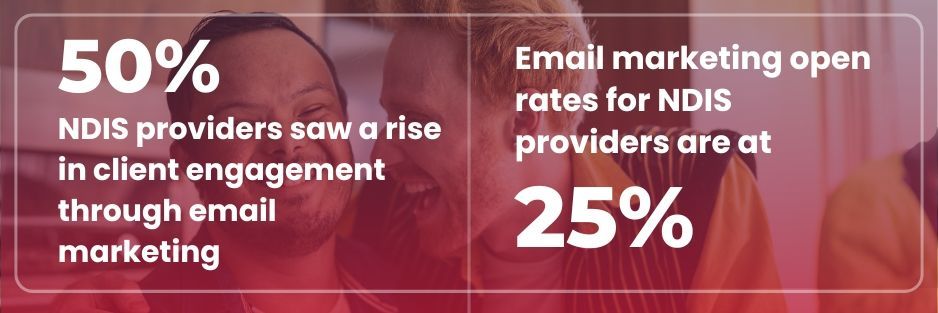Digitial Marketing for
NDIS Providers
As an NDIS provider, you navigate a complex landscape of regulations, funding structures, and the diverse needs of your clients. Ensuring compliance with these myriad requirements while delivering high-quality, personalised care is no small feat.
In 2024, the NDIS landscape experienced significant shifts, with new technology-driven initiatives and policy updates enhancing service delivery.
Digital marketing remains a powerful ally in this evolving sector, helping you connect with potential clients, build trust, and showcase your services' value. As a provider, tackling these updated challenges can be daunting. This guide is here to help you navigate these changes, offering actionable strategies to ensure your marketing efforts are both effective and resonate deeply with your audience.
But how do you overcome the specific hurdles that come with marketing in the NDIS space? This guide is here to help you understand these challenges and provide actionable strategies to ensure your digital marketing efforts are not only effective but also deeply resonant with your audience.
Explore the following statistics to understand the significance of digital marketing within the NDIS sector.
Understanding the Unique Challenges Faced by NDIS Providers
As an NDIS provider, you’re well aware that delivering exceptional services involves navigating a landscape of intricate regulations, funding constraints, and heightened expectations from clients and their families.
These unique challenges can hinder growth and complicate differentiation in a competitive market. Considering the significant impact your services have on the quality of life for people with disabilities, it’s essential to master your digital marketing efforts. By doing so, you can attract new participants and maintain the trust and satisfaction of those you already support.
One of the primary challenges NDIS providers face with digital marketing is the highly competitive landscape. With numerous providers vying for the attention of potential clients, standing out can be difficult.
This necessitates a well-thought-out strategy to differentiate services and communicate unique value propositions effectively.
Another significant challenge is the need for compliance with strict regulations and guidelines. NDIS providers must ensure that their marketing efforts adhere to the standards set by the NDIS Quality and Safeguards Commission. This includes accurate representation of services, maintaining client confidentiality, and avoiding misleading claims.
NDIS providers often struggle with limited resources, both in terms of budget and personnel. Many providers operate on tight margins and may not have dedicated marketing teams. This makes it challenging to implement and sustain comprehensive digital marketing campaigns, which require consistent effort and expertise.
Understanding and effectively targeting the right audience is another hurdle. The NDIS community is diverse, with varying needs and preferences. Crafting personalised and relevant content that resonates with different segments of this audience can be complex and time-consuming.
Keeping up with the rapidly evolving digital marketing landscape poses a continuous challenge. New platforms, tools, and algorithms emerge regularly, requiring providers to stay updated and adapt their strategies accordingly. This can be particularly daunting for those who are not well-versed in digital marketing.
Measuring the effectiveness of digital marketing campaigns can be difficult for NDIS providers. Unlike traditional marketing, digital marketing offers a plethora of metrics and data points. However, interpreting this data to gain actionable insights and demonstrate return on investment (ROI) can be challenging without the right tools and expertise.
Building and maintaining trust online is crucial yet challenging for NDIS providers. Potential clients and their families need to feel confident in the provider's ability to deliver quality care. Establishing credibility through online reviews, testimonials, and transparent communication is essential but requires consistent effort and positive client experiences.
The Power of Your Website: A Digital Hub for NDIS Services
Your website serves as the frontline of your digital marketing efforts. It is the virtual 'shop front' for your services, where potential clients and their families first encounter your offerings.
A well-designed, user-friendly website is essential for making a solid first impression. But it's not just about aesthetics; it’s about functionality and accessibility too.
Why is this important?
Because your audience includes individuals with disabilities, who may rely on assistive technologies to navigate the internet.
Ensuring your website meets
WCAG (Web Content Accessibility Guidelines)
is crucial. Features like text-to-speech, keyboard navigation, and alt text for images are not just beneficial—they're necessary to create an inclusive experience.
Additionally, your website should clearly present all the services you provide, along with easy-to-access contact information.
Consider incorporating an FAQs section to address common inquiries. This not only improves user experience but also establishes trust. Highlighting client testimonials and success stories will further validate your services, offering social proof that can convert visitors into clients.
Furthermore, a regularly updated blog can serve as an invaluable resource. Sharing informative articles about NDIS topics, news updates, and tips on navigating the system can position your website as a go-to hub for relevant information. It helps in maintaining engagement, driving traffic, and enhancing your SEO efforts.
Interactive elements, such as quizzes or self-assessment tools, can engage visitors more actively. A well-integrated booking or consultation form can streamline the process of getting in touch with you, making it convenient for prospective clients to take the next step.
Don’t forget to include social media integration, encouraging users to follow your profiles and stay updated with your latest offerings.
Finally, ensure your website is mobile-friendly. As more people access the internet via smartphones and tablets, it's vital that your website offers a seamless mobile experience.
In summary, your NDIS provider website should, not only attract and educate but also engage and convert. It must be a comprehensive digital hub that serves the diverse needs of your NDIS clients effectively. Hiring a web design agency specialised in NDIS services is the first step in this process. Google,
Web Designer for NDIS Providers or
NDIS web designer to see who comes up, check their portfolio and discuss with them to see if they resonate with your scheme of things. Do not fall for cheap packages on display or 'ready to do anything' attitude of web design agencies as quite often they are dying to get projects due to their incompetence.
Paid Ads vs. Organic Content: Which is Best for NDIS Providers?
When considering paid ads versus organic content, it's crucial to understand how each strategy fits into your broader marketing goals as an NDIS service provider. Both approaches have their unique advantages, and the best results often come from a balanced combination of the two.
Ultimately, integrating both approaches ensures that you benefit from the immediacy of paid ads and the lasting impact of organic content. Start by assessing your budget and determine how much you can allocate to paid advertising while maintaining a consistent output of high-quality organic content.
Regularly evaluate the performance of both strategies and adjust your tactics based on what drives the best results for your NDIS business.
Combining paid ads and organic content can effectively enhance your digital marketing efforts, allowing you to reach more potential clients and sustainably grow your NDIS service provider business.
Paid advertising offers quick visibility and immediate results, allowing you to target specific demographics, locations, and interests. This can be particularly effective in reaching carers and families looking for NDIS services. Organic growth takes time but results in a loyal following and sustained engagement.
SEO Strategies to Boost Your NDIS Website Visibility
To enhance your NDIS service's online presence, SEO (Search Engine Optimisation) is paramount. Begin by conducting thorough keyword research. Identify terms and phrases your target audience is likely to use when seeking NDIS services. Tools like Google Keyword Planner or Ahrefs can be beneficial in uncovering relevant keywords.
Once you've determined your keywords, integrate them naturally into your website content, including meta titles, descriptions, headings, and body text. This makes it easier for search engines to understand what your site is about and rank it accordingly.
On-Page SEO:
Ensure all your web pages are optimised for these keywords. Use clear and concise headings (H1, H2, H3) and incorporate keywords into your URLs. Additionally, optimise your images by using descriptive file names and alt texts that include your keywords.
Technical SEO:
This entails improving the backend structure of your website. Ensure your site loads quickly, is mobile-friendly, and has an SSL certificate for added security. Employ structured data for local SEO, which helps search engines understand your business and boosts your chances of appearing in local search results.
Creating high-quality, informative content is another crucial aspect of effective SEO. Develop content that addresses the needs and challenges of your audience. For example, blog posts on navigating the NDIS process or success stories from your clients can attract and engage your target audience.
Moreover, don't overlook the importance of backlinking. Get other reputable websites to link back to your content, which signals to search engines that your site is a credible source of information. You can achieve this through guest blogging, partnerships, or even local directories.
Leveraging
Google Analytics
and Search Console is also essential. These tools provide insights into how your site performs and where you can make improvements. Regularly monitor your site's traffic, bounce rates, and search rankings to adjust your strategy as needed.
Finally, always keep accessibility in mind. An accessible website is not only beneficial for users with disabilities but also favoured by search engines. Use proper HTML tagging for screen readers, provide transcripts for video content, and ensure your site is navigable via keyboard.
Maximising ROI with Targeted Paid Advertising Campaigns
Your primary goal with targeted paid advertising is to maximise your return on investment (ROI). This means every dollar spent should translate to increased engagement, leads, or conversions. In 2024, there are several strategies that can help you achieve this:
1. Identify Your Audience
Start by defining your target audience. As an NDIS provider, you need to focus on individuals who require disability support services, their families, and support coordinators. Understand their needs, preferences, and online behaviour to create ads that resonate.
2. Utilise Advanced Targeting Options
Platforms like Google Ads and Facebook Ads offer robust targeting options. Use these to narrow down your audience based on demographics, interests, and behaviours. For instance, you can target carers or people searching for NDIS-related information.
3. Craft Compelling Ad Copy and Visuals
Your ad copy and visuals should be clear, concise, and engaging. Highlight how your services make a difference in your clients' lives. Ensure your visuals are inclusive, representing the diversity within the NDIS community.
4. Monitor and Optimise Campaigns Regularly
Analyse the performance of your ads consistently. Utilise A/B testing to understand what works best. Adjust your strategies based on data-driven insights to improve click-through rates (CTR) and conversion rates.
5. Set Clear Goals and KPIs
Define specific goals for your campaigns, such as the number of leads generated or a certain increase in website traffic. Establish key performance indicators (KPIs) to measure success and guide your optimisation efforts.
6. Leverage Remarketing Tactics
Remarketing allows you to target users who have previously interacted with your website or ads. This is particularly effective for NDIS services, where decisions often involve careful consideration. Keep your brand top-of-mind and encourage potential clients to return and engage.
By implementing these strategies, you can ensure that your paid advertising campaigns are not only reaching the right audience but also eliciting the desired response. This focused approach will help you maximise your ROI and build a robust presence in the NDIS sector.
Leveraging Social Media to Connect with Your Audience
Social media platforms offer a unique opportunity for NDIS service providers to connect with their audience on a more personal level. By utilising platforms such as Facebook, Instagram, and LinkedIn, you can not only showcase your services but also share stories, updates, and valuable information that resonates with your target audience.
It's crucial to understand where your audience spends most of their time online. For instance, families and carers might frequent Facebook for community support groups, while younger participants might be more active on Instagram.
Tailoring your content to each platform ensures better engagement and fosters a sense of community.
Content Ideas:
- Success stories and client testimonials that highlight the impact of your services.
- Educational posts that provide insights into NDIS processes and benefits.
- Behind-the-scenes glimpses of your dedicated team at work.
- Interactive polls and question-and-answer sessions to engage your audience.
- Video content featuring day-in-the-life stories, facility tours, or expert advice.
Enchancing Your Social Presence
Enchancing your social media presence is not just about posting frequently; it’s about creating meaningful connections with your audience. Here are some top
tips and tricks to elevate your social media game:
1. Develop a Consistent Posting Schedule
Consistency is key to staying top of mind. Create a content calendar that includes a mix of posts, such as educational content, client success stories, and industry news. Regular posting helps build trust and familiarity with your audience.
2. Use Visually Engaging Content
A picture is worth a thousand words, and videos can convey even more. Incorporate high-quality images, videos, and infographics to make your posts stand out. Engaging visuals can significantly increase interaction rates.
3. Share Client Testimonials and Success Stories
Nothing speaks louder than the voice of those you’ve helped. Client testimonials and success stories showcase the impact of your services, providing social proof and building credibility.
4. Engage With Your Audience
Social media is a two-way street. Engage actively with your followers by responding to comments, messages, and reviews. This interaction shows that you value their input and are attentive to their needs.
5. Leverage Hashtags Wisely
Hashtags are essential for expanding your reach. Use a mix of popular and niche hashtags relevant to the NDIS community to connect with a broader audience. Research trending hashtags and incorporate them into your posts.
6. Collaborate with Influencers and Advocates
Partnering with influencers and advocates in the disability sector can amplify your message. These collaborations can introduce your services to larger, more engaged audiences and foster trust.
7. Utilise Social Media Analytics
Track your performance with social media analytics tools. Monitor metrics such as engagement rates, click-through rates, and follower growth. Analysing this data helps refine your strategy and improve results over time.
By applying these tips and tricks, you can create a vibrant and engaging social media presence that resonates with your target audience and strengthens your brand’s connection with the NDIS community.
Retargeting Strategies to Keep Potential Clients Engaged
Retargeting involves reaching out to individuals who have previously shown interest in your services but have not yet made a decision. This approach keeps your services at the forefront of their minds and encourages them to take the next step.
Utilising platforms like Google Ads and Facebook Ads makes it easier to implement retargeting campaigns. These platforms offer robust retargeting tools that allow you to create personalised ads and deliver them to your defined audience, increasing the likelihood of converting these potential clients.
Another powerful tool in your retargeting arsenal is email marketing. Consider sending personalised follow-up emails to users who have interacted with your website but haven't committed yet. Include information that directly addresses their interests or concerns, such as case studies, testimonials, or special offers. This not only reiterates your value proposition but also shows your commitment to their needs.
Remember, retargeting isn't just about persistent reminders; it's about providing value. Ensure that the content you push through retargeting efforts offers meaningful insights or incentives that resonate with your audience's needs and preferences. Perhaps include educational content that answers frequently asked questions or common concerns they may have.
The Role of Email Marketing in NDIS Engagement
Email marketing remains a powerful tool to build and nurture relationships with your clients and their families. Unlike social media platforms, email offers a direct and personal communication channel. For NDIS providers, this means you can deliver tailored content that speaks directly to your audience's needs.
Segmentation is Key
Begin by segmenting your email list. Group your recipients by their specific needs, demographics, or their stage in the client journey. This allows you to send targeted emails that are more likely to resonate and engage. For example, you might have separate segments for new clients, long-term clients, or those who have expressed interest in specific services.
Content Should Be Valuable and Relevant
Ensure that your emails provide value. Share updates about your services, success stories, and tips that can help clients improve their quality of life. Educational content, such as guides on navigating NDIS plans or understanding their rights and entitlements, can position you as a trusted resource.
- Updates on service offerings
- Client success stories
- Educational guides and tips
Personalisation Improves Engagement
Personalised emails see higher engagement rates. Use your subscribers’ names and tailor the content to reflect their interests and needs. A simple 'Happy Birthday' message or acknowledging the anniversary of their enrolment with your services can make a substantial difference in how connected they feel to your organisation.
Call-to-Action (CTA)
Each email should include a clear and compelling call-to-action. Whether you want your reader to schedule a consultation, check out a new blog post, or follow your social media profiles, make it easy for them to take the next step.
By crafting strategic and empathetic email campaigns, you can build stronger relationships with your clients, foster loyalty, and ultimately drive engagement and growth for your NDIS services.
Building Partnerships and Collaborations for Greater Reach
Collaborations and partnerships can play a pivotal role in expanding your NDIS service reach. By aligning with complementary businesses and organisations, you can tap into new networks and broaden your service offering. One effective strategy is to partner with local health clinics, therapy centres, and community groups that share a similar audience.
When approaching potential partners, it’s crucial to highlight the mutual benefits of collaboration. Will you be providing additional value to their clients? Can you co-create programs or resources that benefit both parties? A well-planned partnership can lead to shared responsibilities, costs, and an enhanced reputation in the community.
Joint Events and Workshops
Organising joint events or workshops can significantly boost visibility and provide value to both your audience and your partner’s. These activities not only showcase your expertise but also foster a sense of community. Consider hosting webinars focused on specific challenges faced by NDIS participants or informational sessions about navigating the NDIS system. Through such events, you can also gather valuable feedback and insights on participant needs, helping refine your services.
Co-branded Content
Another excellent way to collaborate is through co-branded content. This could include blog posts, infographics, or videos that bring together expertise from both your organisation and your partner's. Such content can be shared across both networks, ensuring maximum reach and engagement. For example, you could team up with a mental health organisation to create a series of videos on managing stress for NDIS participants.
Furthermore, don't overlook the value of social media collaborations. Cross-promotions on platforms like Facebook and Instagram can drive significant traffic to both parties' websites. It's a win-win scenario that boosts online engagement and expands your reach in the digital space.
To ensure the success of your partnerships, clear communication and defined goals are essential. Regularly review the outcomes of your collaborations and make adjustments as needed. This continuous evaluation will help you identify what’s working and where improvements are necessary, thus maximising the impact of your partnerships.
In conclusion, by forming strategic partnerships, you not only enhance your reach but also build a stronger, more supportive community for your NDIS services. Embrace opportunities for collaboration and watch your network, and your impact grows.
Managing Your Online Reputation as an NDIS Provider
Managing your online reputation is crucial for your NDIS service provider business. In today's digital age, your online presence often forms the first impression for potential clients and their families. Therefore, a strategic approach to reputation management can not only help you maintain a positive image but also attract new clients and retain existing ones.
Firstly, it's essential to actively monitor online reviews. Platforms such as Google My Business, Facebook, and industry-specific forums are common places where clients leave feedback. Setting up Google Alerts for mentions of your business can help you stay informed. Prompt responses to both positive and negative reviews demonstrate your commitment to client satisfaction.
Moreover, engage proactively with your audience on social media. Regular interactions, whether through posts, comments, or direct messages, show that your business values its community. Highlighting success stories and positive outcomes can bolster your company's image and provide reassurance to prospective clients.
Additionally, consider building relationships with your offline networks and partners. Word-of-mouth referrals from trusted community health professionals can significantly enhance your reputation. Engaging in collaborative projects or community events increases your visibility and reinforces your credibility.
Lastly, don't underestimate the power of transparency and accountability. Clearly communicating your services, processes, and policies builds trust. If issues arise, addressing them openly and working towards solutions can convert a negative situation into a demonstration of your reliability and commitment to quality care.
Summary:
As you navigate digital marketing in 2024 and beyond, it's vital to shape your strategies to meet the specific needs of NDIS participants, their families, and stakeholders. By building a strong online presence, using websites, social media, e-mail marketing, balancing paid and organic content, and employing SEO strategies, you can boost your visibility and connect with your audience more effectively.
DSIGNS has been a trusted partner in the NDIS space since 2017. We've helped numerous businesses grow from their early stages to industry leaders in a short time. If you're looking for a reliable digital marketing partner, we're here to assist.
Visit this link
to explore our strategies, past works, and testimonials. Book a free consultation, and we’ll get in touch with you soon.
























